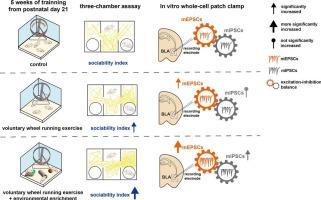Voluntary exercise combined with environmental enrichment during adolescence promotes sociability and maintains excitation-inhibition balance of Amygdala’s synaptic transmission in mice
IF 2.8
3区 医学
Q2 NEUROSCIENCES
引用次数: 0
Abstract
Social behavior is a complex social trait in animal survival, which is influenced by intrinsic states and environmental factors. The basolateral complex of the amygdala (BLA) has been demonstrated to play a pivotal role in regulating social behavior. The effects of physical exercise and environmental enrichment on social behavior and the underlying neural mechanisms remain poorly understood. This study investigated how 5 weeks of single voluntary wheel running exercise (Ex) or Ex combined with environmental enrichment (Ex + EE) from postnatal day 21 (post-weaning) affects social behavior and BLA synaptic transmission in male mice. The results showed that single Ex enhanced sociability, accompanied by a significant increase in mEPSCs’ frequency/amplitude of BLA pyramidal neurons, suggesting that voluntary exercise during adolescence may promote social behavior by potentiating excitatory synaptic afferents of BLA pyramidal neurons. Further, Ex + EE more effectively enhanced sociability and increased both mEPSCs’ frequency/amplitude and mIPSCs’ frequency/amplitude in BLA pyramidal neurons. The concurrent potentiation of excitatory and inhibitory synaptic transmission in BLA pyramidal neurons highlights the potential key role of excitation-inhibition balance of BLA synaptic afferents in modulating social behavior. These findings provide a possible amygdala mechanism underlying the effects of physical exercise and environmental enrichment during adolescence on social behavior.

青少年期自愿运动与环境丰富相结合,可促进小鼠的社交能力,维持杏仁核突触传递的兴奋-抑制平衡。
社会行为是动物生存过程中一种复杂的社会特征,受内在状态和环境因素的影响。杏仁核基底外侧复合体(BLA)已被证明在调节社会行为中起关键作用。体育锻炼和环境丰富对社会行为的影响及其潜在的神经机制尚不清楚。本研究研究了从出生后第21天(断奶后)开始进行5 周的单轮自主跑步运动(Ex)或Ex结合环境富集(Ex + EE)如何影响雄性小鼠的社会行为和BLA突触传递。结果表明,单Ex增强了社交能力,同时BLA锥体神经元mEPSCs的频率/振幅显著增加,表明青春期自发性运动可能通过增强BLA锥体神经元的兴奋性突触传入来促进社交行为。此外,Ex + EE更有效地增强了BLA锥体神经元的社交性,增加了mEPSCs的频率/振幅和mIPSCs的频率/振幅。BLA锥体神经元兴奋性和抑制性突触传递的同时增强,突出了BLA突触传入的兴奋-抑制平衡在调节社会行为中的潜在关键作用。这些发现为青少年时期体育锻炼和环境丰富对社会行为的影响提供了一种可能的杏仁核机制。
本文章由计算机程序翻译,如有差异,请以英文原文为准。
求助全文
约1分钟内获得全文
求助全文
来源期刊

Neuroscience
医学-神经科学
CiteScore
6.20
自引率
0.00%
发文量
394
审稿时长
52 days
期刊介绍:
Neuroscience publishes papers describing the results of original research on any aspect of the scientific study of the nervous system. Any paper, however short, will be considered for publication provided that it reports significant, new and carefully confirmed findings with full experimental details.
 求助内容:
求助内容: 应助结果提醒方式:
应助结果提醒方式:


